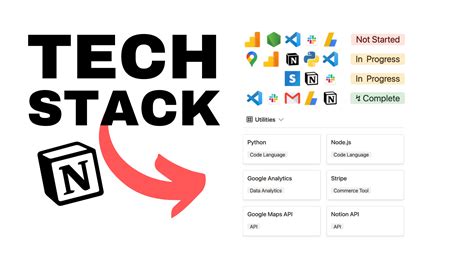Notion, a popular productivity and collaboration tool, has been gaining traction among developers due to its flexibility and customization capabilities. In this article, we'll delve into the Notion tech stack, exploring its various components, benefits, and limitations. Whether you're a seasoned developer or just starting to explore Notion's capabilities, this guide will provide you with a comprehensive understanding of the Notion tech stack.
What is Notion?
Notion is an all-in-one workspace that allows users to create notes, databases, Kanban boards, and more. Founded in 2013 by Ivan Zhao and Simon Last, Notion aims to provide a flexible and customizable platform for individuals and teams to manage their work and personal projects. Notion's popularity has grown significantly over the years, with millions of users worldwide.
Notion Tech Stack Components
The Notion tech stack consists of several key components:
Frontend
Notion's frontend is built using a combination of technologies, including:
- React: A popular JavaScript library for building user interfaces.
- JavaScript: Used for client-side scripting and creating interactive elements.
- HTML: Used for structuring and formatting content.
- CSS: Used for styling and layout.

Backend
Notion's backend is built using:
- Node.js: A JavaScript runtime environment for building server-side applications.
- Express.js: A popular Node.js framework for building web applications.
- PostgreSQL: A relational database management system for storing and managing data.

Database
Notion uses a combination of databases to store and manage data:
- PostgreSQL: Used for storing and managing structured data.
- Redis: An in-memory data store for caching and storing temporary data.
- LevelDB: A lightweight, embeddable database for storing and managing user data.

Benefits of the Notion Tech Stack
The Notion tech stack offers several benefits, including:
- Flexibility: Notion's tech stack allows for customization and flexibility, making it suitable for a wide range of use cases.
- Scalability: Notion's use of cloud-based services and distributed databases enables it to scale horizontally and handle large volumes of traffic.
- Performance: Notion's use of caching and content delivery networks (CDNs) ensures fast page loads and a responsive user experience.
Limitations of the Notion Tech Stack
While the Notion tech stack offers several benefits, it also has some limitations:
- Complexity: Notion's tech stack can be complex and challenging to manage, especially for smaller teams or individuals.
- Security: Notion's use of a combination of databases and caching layers can introduce security risks if not properly configured.
- Cost: Notion's use of cloud-based services and distributed databases can result in higher costs, especially for large teams or enterprises.
Best Practices for Working with the Notion Tech Stack
To get the most out of the Notion tech stack, follow these best practices:
- Keep it simple: Avoid complexity and focus on simplicity when building custom solutions with Notion.
- Use caching: Use caching to improve performance and reduce the load on your databases.
- Monitor and optimize: Monitor your databases and optimize them regularly to ensure optimal performance.
Gallery of Notion Tech Stack






FAQs
What is the Notion tech stack?
+The Notion tech stack consists of several key components, including React, JavaScript, HTML, CSS, Node.js, Express.js, PostgreSQL, Redis, and LevelDB.
What are the benefits of the Notion tech stack?
+The Notion tech stack offers several benefits, including flexibility, scalability, and performance.
What are the limitations of the Notion tech stack?
+The Notion tech stack has several limitations, including complexity, security risks, and cost.
Conclusion
In conclusion, the Notion tech stack is a powerful and flexible platform for building custom solutions. By understanding the various components of the Notion tech stack and following best practices, developers can create high-performance and scalable applications. Whether you're a seasoned developer or just starting to explore Notion's capabilities, this guide has provided you with a comprehensive understanding of the Notion tech stack.
We hope this article has been informative and helpful. If you have any questions or need further clarification, please don't hesitate to ask. Share your thoughts and experiences with the Notion tech stack in the comments below.
